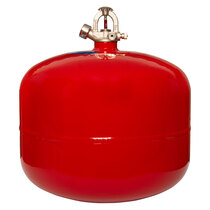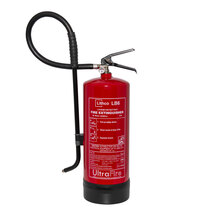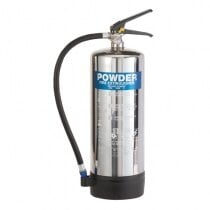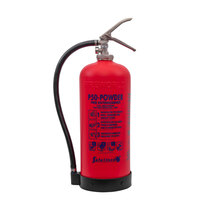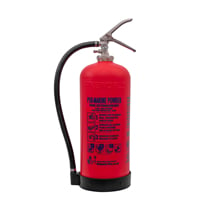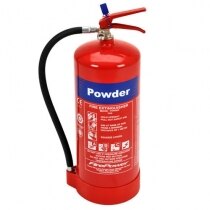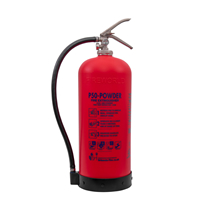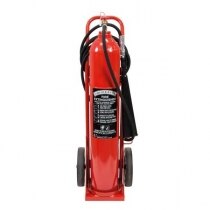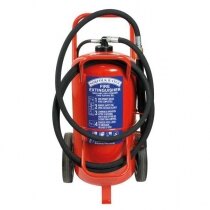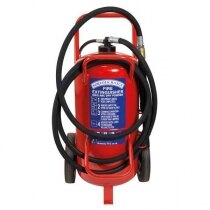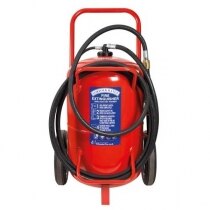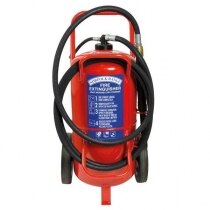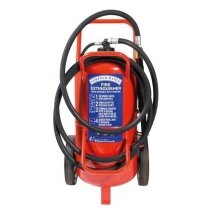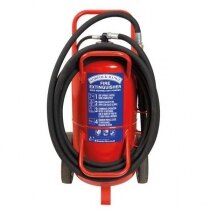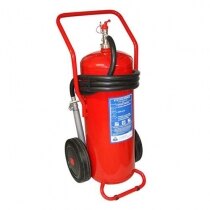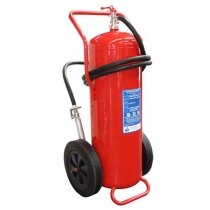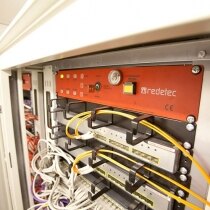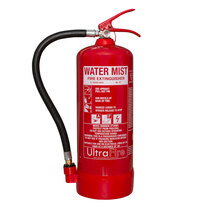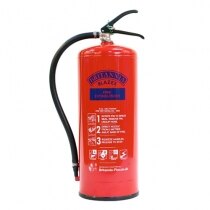-
Contact
Sales & Customer Service
0800 612 6537 support@safelincs.co.uk Live ChatDelivery Enquiries
0800 077 6149 - Resources
Fire & Safety Solutions
CALL OUR TEAM NOW 0800 612 6537
Also FREE from UK mobiles
FREE Delivery
on marked products
Live Chat - Online
Instant help & Advice
Trade Discounts
and exclusive pricing
0% Credit Available
Open an account now
5 Star Customer Feedback
Fire Extinguishers for Electrical Equipment
When electricity meets fire, choosing the proper extinguisher becomes critical for your safety. Our range of fire extinguishers for electrical equipment provide a solution for tackling electrical equipment hazards in a range of environments. Different types of fire extinguishers you should use on live electrical equipment The answer depends on the voltage, the type of equipment and your specific environment. However, modern testing standards have significantly expanded your options. Traditional choices: Modern innovations: What makes an electrical fire different? Technically, electricity itself doesn’t burn. Often, it is the cable covering or foreign bodies that ignite first. If the supply continues, this is considered a fire involving live electrical equipment. The real danger comes from the continued power supply, which can electrocute anyone using the wrong extinguisher. Why choose our electrical fire extinguishers? Safety first — Every extinguisher in our electrical range meets rigorous safety standards. Water mist and eco-foam undergo 35kV dielectric testing, marked ‘Suitable for use on Live Electrical Equipment up to 1000V at a distance of 1 metre’. Minimal damage — Our dry water mist extinguishers discharge de-ionised water in a mist that cannot carry current, protecting you and your equipment. Versatile protection — Water mist handles Class A, B, and electrical fires; eco-foam adds Class F capability. Service-free options — P50 service-free extinguishers need no servicing for 10 years, only annual visual checks. Our electrical fire extinguisher range includes: Where should you install electrical fire extinguishers? Offices, server rooms, workshops, kitchens, and homes with electrical items all need coverage. When planning, consider risks from laptops, printers, kettles, or washing machines. Professional guidance — Our expert team can assess your electrical risks and recommend the most suitable fire safety equipment. We’ll help you comply with regulations and ensure cost-effective protection. Browse our range here or call Safelincs on 0800 612 6537 for personalised advice. Frequently Asked Questions (FAQs) What’s the difference between an electrical fire and a regular fire? Electricity itself doesn’t burn — surrounding materials ignite. If supply remains live, electrocution risk is high, making standard water extinguishers unsafe unless tested. Can I use water mist extinguishers on live electrical equipment? Yes, if they’ve passed BS EN3-7 dielectric testing. These use de-ionised water mist that doesn’t conduct electricity. Why are CO2 extinguishers still recommended? They don’t conduct electricity and leave no residue, ideal for server rooms and electronics. Ventilation is essential after use. What does ‘di-electrical testing’ mean? It subjects extinguishers to 35,000 volts to ensure safety. Certified units are marked safe for up to 1000V at 1 metre. Can I use the same extinguisher for electrical and other fires? Yes, modern multi-class models (water mist, eco-foam) cover electrical, Class A, B, and even Class F risks.
Read more...
Large Automatic Powder Fire Extinguishers
Available in both 6kg and 10kg models, these automatic extinguishers are perfect for unmanned, confined locations.
- Extinguisher fixings included
- Effective on class A, B & C fires
- Suitable for engines and machine rooms
- CE Marked
Lithco LB6 Lithium-Ion Battery 6ltr Fire Extinguisher - UltraFire
Designed specifically for use on rechargeable lithium-ion battery fires, the LB6 fire extinguisher satisfies modern fire risks in a cost-effective, multi-purpose solution.
- Designed for UPS systems, laptops, power tools, and bulk device chargers
- Heat dispersing, low-viscosity agent to penetrate battery casings
- Rigid applicator lance for enhanced control and user safety
- Third-party tested up to 360Wh battery capacity
Stainless Steel 6kg Dry Powder Fire Extinguisher
A corrosion-resistant and elegant looking unit, the 6kg stainless steel powder fire extinguisher is ideal for commercial installation.
- Extinguisher Rating: 43A, 233B, C
- 5 year warranty
- CE marked and Lloyd's Registered
- Highly polished surface finish & corrosion resistant
P50 Service-Free 6kg Powder Fire Extinguisher
A fire extinguisher that is Kitemarked and CE Marked and doesn't require an extinguisher company to service it. Reduce your maintenance costs.
- Extinguisher Rating: 43A, 233B & C
- Kitemarked by BSI to BS EN3
- Manufactured in the UK
- Price includes site survey, install and commissioning
P50 MED Service-Free 6kg Powder Fire Extinguisher
These MED Approved and Kitemarked extinguishers do not need annual servicing by an extinguisher company and are fitted with Schrader valves for easy refilling.
- Extinguisher Rating: 43A, 233B, C
- Service-free fire extinguisher - fitted with Schrader valve
- MED Approved
- Manufactured in the UK
- Price includes site survey, install and commissioning
Thomas Glover 9kg Monnex Powder Extinguisher
A super powder fire extinguisher that is the most effective at tackling large flammable liquid fires such as fuel, alcohol and paint. Ideal for petrol stations, fuel depots, airports.
- Extinguisher Rating: 233B, C
- 5 year warranty
- Kitemarked and CE marked
- High performance Monnex Powder with corrosion free valve assembly
P50 Service-Free 9kg Powder Fire Extinguisher
Kitemarked and CE Marked, this extinguisher does not require an extinguisher company to service it. Reducing your maintenance costs and saving you money.
- Extinguisher Rating: 55A, 233B & C
- Kitemarked by BSI to BS EN 3
- Over 2kg lighter than normal 9kg powder extinguishers
- Manufactured in the UK
- Price includes site survey, install and commissioning
Britannia Norfolk 20kg Wheeled CO2 Extinguisher
This wheeled CO2 extinguisher utilises a 6 metre reinforced hose for up to 44 seconds discharge over 4 metres, tested to BS EN 1866-1 and with the prestigious MED Marine Approval.
- Suitable for Class B fires involving live electrical equipment
- 20kg capacity
- CO2 (carbon dioxide) extinguishing agent
- MED Marine Approved
Britannia Norfolk 50kg Wheeled ABC Dry Powder Extinguisher
This Norfolk wheeled extinguisher utilises a 5 metre reinforced hose to support a discharge range of up to 15 metres over 35 seconds, CE Marked & tested to BS EN3.
- 50kg capacity and suitable for use on Class A, B, and C fires
- 10 year warranty
- CE marked and MED Marine Approved
- ABC dry powder extinguishant
Britannia Norfolk 60kg Wheeled ABC Dry Powder Extinguisher
This Norfolk wheeled extinguisher is designed to tackle Class A, B and C fires, with a discharge duration of 38 seconds over a range of 14 metres.
- 60kg capacity and suitable for Class A, Class B and Class C fires
- 10 year warranty
- CE Marked
- ABC Dry Powder extinguishant
Britannia Norfolk 100kg Wheeled ABC Dry Powder Extinguisher
This Norfolk wheeled 100kg powder extinguisher is designed for use on industrial-scale Class A, B and C fires, providing up to 80 seconds of continuous use over a range of 14 metres.
- 100kg capacity and designed to combat Class A, Class B and Class C fires
- 10 year warranty
- CE marked
- ABC dry powder extinguishant
Britannia Norfolk 45kg Wheeled Monnex Powder Extinguisher
Britannia's 45kg Monnex powder Norfolk wheeled extinguisher is rated for Class B and C fires, as well as for use near live electrical equipment, providing up to 44 seconds of continuous use.
- 45kg capacity and suitable for Class B and Class C fires
- 10 year warranty
- CE Marked
- Monnex powder extinguishing agent
Britannia Norfolk 50kg Wheeled Monnex Powder Extinguisher
This Monnex powder wheeled extinguisher can be used for Class B and C fires, as well as near live electrical equipment, with a discharge range of up to 14 metres.
- 50kg capacity and designed to combat Class B and Class C fires
- 10 year warranty
- CE Marked
- Monnex powder extinguishing agent
Britannia Norfolk 63kg Wheeled Monnex Powder Extinguisher
This Britannia Norfolk wheeled extinguisher is ideal for industrial-scale Class B and C fires due to the expansive nature of Monnex Powder, as well as near live electrical equipment due to it being a non-conducitve chemical.
- 63kg capacity and ideal for large Class B and Class C fires
- 10 year warranty
- CE Marked
- Monnex Powder extinguishing agent
50kg Powder Wheeled Fire Extinguisher
This large wheeled extinguisher has industrial fire fighting capabilities and is able to tackle class A, B and C fires.
- Ideal for installation in factories, storage units, fuel stores
- Refillable stored pressure unit
- Fire extinguisher rating ABC and electrical fires
- Manufactured to EN 1866-1 standards
- MED Marine Approval
100kg Powder Wheeled Fire Extinguisher
Approved for use on marine applications and over 1 minute of discharge, the 100kg powder is designed to tackle large fires on an industrial level.
- Ideal for installation in factories, storage units, fuel stores
- Refillable stored pressure unit
- Fire extinguisher rating ABC and electrical fires
- Manufactured to EN 1866-1 standards
- MED Marine Approval
Redetec Novec 1230 Rack Mounted Automatic Fire Suppression Unit
The Novec 1230 systems come in two sizes to cover either 1.5m3 or 3.0m3 of space in 19" server racks. Slimline, low profile rack design.
- Provides fire detection and protection for electronic equipment
- Designed around EN 54-2 C&IE standards and EMC tested
- Automatic release of extinguishant upon detector activation
- Environmentally friendly Novec 1230 extinguishing gas
- Includes 2 built-in LPCB approved conventional photoelectric smoke detectors
6ltr Wet Chemical, 2kg CO2 Fire Extinguisher & Fire Blanket Special Offer
This money saving special offer, aimed at commercial and industrial kitchens, includes a 6ltr wet chemical extinguisher, a 2kg CO2 fire extinguisher and a 1.0m x 1.0m fire blanket.
- FREE next working day delivery
- Wet chemical extinguisher rating: 13A, 75F and Electrical
- CO2 extinguisher rating: 34B and Electrical
- Ideal for commercial and industrial kitchens
3ltr Water Mist Fire Extinguisher - UltraFire
Utilising the latest in water mist technology, the 3l water mist is suitable for private homes as well as business environments.
- Effective on A, B, C, and F type fires
- Safe on live electrical equipment up to 1000V
- 100% non-harmful and 100% clean agent
- Kitemarked and CE marked
9kg Powder Fire Extinguisher - Britannia
An extremely powerful fire-fighter, this large powder extinguisher is ideal for industrial environments where highly flammable materials may be present.
- Extinguisher Rating: 34A, 233B, C
- 10 year warranty - Exclusive to Safelincs
- Kitemarked to BS EN 3: 1996 and CE marked
- UK Manufactured
Page 2 (40 of 51 Products)
What is Di-electric Testing?
Di-electrical testing verifies that even with an incredibly high voltage of 35,000 Volt, no electrical current can flow back to the person discharging the extinguisher on a fire involving live electricity. The test consists of certain test distances between the user and the fire.
Once an extinguisher has passed this stringent test, it is still limited for safety reasons. The limits, which are found on electrically safe extinguishers, are a maximum of 1000 Volt and a minimum distance between the extinguisher and the fire of 1 metre (1000V is four times the voltage used in a domestic premises).
If a liquid extinguishing agent is used on a fire involving live electrical equipment, there is still a risk of a pool forming. The risk of electrocution for the user is reintroduced and increased if they were to stand in the pool. However, it is key to remember that the use of any liquid on live electrical equipment usually leads to immediate fuse-triggering and power is cut off to the electrical device.
Our range of dry water mist extinguishers, although a liquid based extinguishing agent, discharges de-ionised water in an extremely fine mist by a specially designed spray nozzle. Pooling is almost impossible by this method, and de-ionised water cannot carry an electrical current which reduces the risk of electrocution even further with minimum damage to the equipment.
What is an Electrical Fire?
Technically, there is no such thing as an electrical fire, as electricity itself does not burn and neither do the cable cores and other conductors. However, the electrical current can heat up other materials that may be on top of the cables or around the plug sockets, and this would be the start of what is considered to be an electrical fire.
Often, it is the cable covering or even foreign bodies in the electrical equipment that start to burn first. If the electrical supply to the equipment on fire continues, this is what is considered to be a fire involving live electrical equipment. The use of, for example, a simple water extinguisher could then lead to electrocution of the individual fighting the fire.
Therefore, when planning for extinguishers and what types you may require for your business or home, you must consider all risks, including what electrical equipment you may have to use, such as, laptops, printers, kettles, or washing machines.
Our section of electrically safe extinguishers will help you select a suitable extinguisher for your building or application.
What Extinguishers are Suitable for Live Electrical Equipment?
Historically and traditionally, CO2 fire extinguishers have been the number one choice for fire risks involving electrical equipment, as the gas extinguishing agent does not carry electricity. However, unless contained, CO2 gas can drift off and disperse quickly and the fire can re-ignite.
Powder extinguishers have also been known to be used on these types of fires, as they are powerful and do not conduct electricity. However, powder extinguishers are not recommended for use indoors any longer, as they can cause inhalation issues and impair the visibility of the escape route.
Newer types of extinguishing agents, such as water mist and eco-foams, have been developed in such a manner to overcome traditional solutions and provide an environmentally safe alternative.
Water Mist extinguishers have been specially developed to provide effective fire-fighting capabilities with little to no damage to property. With de-ionised water and a specially designed spray nozzle discharging a very fine mist blanket, this extinguisher does not create pools of liquid when tackling a fire, further protecting the user from both the fire and subsequent electrocution.
Eco-foams, a more recent developed extinguishing agent which overcomes the discontinuation of AFFF foams, has been developed to provide a solution to most fire classes including electrical. The extinguishing agent is free from harmful PFAS chemicals, making it a more environmental choice, as well as having high ratings for other fire classes.




















